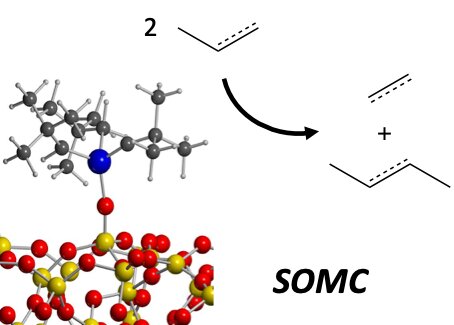December 12, 2019 feature

To convert hydrocarbons into fuel, the petrochemical industry currently relies primarily on heterogeneous catalysts, which in most cases contain active metal sites with poorly defined structures. In recent years, however, an area of study known as surface organometallic chemistry (SOMC) has enabled the design and development of far more defined, so-called single-site catalysts, in which metal sites can be tailored to meet specific requirements.
Christophe Copéret, a professor at ETH Zürich, has been investigating the potential of SOMC for synthesizing fuels and energy carriers in ways that have so far been unattainable using traditional techniques. In a recent paper published in Nature Energy, he writes that SOMC may open new routes for hydrocarbon conversion, as well as how it can contribute to the discovery of important alkane homologation processes and to the understanding of heterogeneous catalysts.
"I am interested in understanding complex systems such as heterogeneous catalysts at the molecular level," Copéret told TechXplore. "Toward that goal, our laboratory has developed expertise to generate well-defined surface species where metal sites are anchored to surfaces as a first step via grafting."
In order to create catalysts with well-defined surface structures, researchers need to control the density and nature of the surface functionalities that are used to anchor tailored molecular precursors. In their past research, Copéret and his colleagues showed that the resulting well-defined surface sites, also referred to as single sites, can outperform both homogeneous and classical heterogeneous catalysts.
These catalysts perform far better than the corresponding supported metal oxide metathesis catalysts used in the petrochemical industry for years. One issue with the latter type of catalysts is the lack of understanding of active site structures that impedes rational development strategies.
"In recent years, we have been interested in understanding the active sites of these supported metal oxides used in industry by exploring methods to generate well-defined surface analogues via our SOMC methodology, namely via anchoring molecular precursors on surfaces and generating isolated metal sites by removing the remaining organic ligands via simple post-treatments," Copéret explained. "Our objective was to generate these well-defined analogues in order to carry out detailed spectroscopic studies with the ultimate goal to derive molecular-level structure-activity relationships and guideline principles to develop these heterogeneous catalysts."
Essentially, SOMC works by controlling the incorporation of metal sites through grafting approaches, ultimately enabling the generation of well-defined surface sites. This molecular approach enables building catalysts with structurally characterized active sites, in stark contrast with industrial catalysts, which are far more complex because of their preparation methods in water, for instance, through precipitation or impregnation of a salt metal.
Conventional techniques for fabricating catalysts tend to yield complex mixtures and ill-defined systems due to the intricate interplay between the metal salts, water and the support that involves multiple dissolution/precipitation events. On the other hand, catalysts resulting from SOMC processes tend to be better-defined, allowing researchers to access structural information about their metal sites.
"Chemistry in water and oxides is far more complicated that one may want to think," Copéret said. "Using our approach, we just simplify the chemistry."
In his recent paper, Copéret summarizes the key assets of SOMC, highlighting its potential for fueling innovation in catalysis and in the petrochemical industry. While there are still several challenges to overcome, he believes that SOMC could eventually help to increase the understanding of catalytic events at a molecular level.
"Catalysts prepared by SOMC provide a very nice model, where spectroscopy provides relevant information about active species, since most of the surface sites are similar in nature by design," Copéret explained. "It also allows one to access the signature of active species and to propose structural information about active sites in the corresponding industrial catalysts."
So far, Copéret and his collaborators at ETH Zürich have successfully used SOMC to understand the active sites of heterogeneous catalysts for the metathesis and polymerization of olefins, as well as for propane dehydrogenation. The molecular understanding derived from these models could ultimately serve as a guiding principle to prepare heterogeneous catalysts in a more rational way and has already been used to develop low temperature metathesis processes.
The researchers are now carrying out further studies in which they plan to use the single sites developed using SOMC to control interfaces and composition of far more complex systems, such as supported nanoparticles, an even larger class of heterogeneous catalysts. In these systems, the metal(s), the support, and promoters play important roles, yet they are often poorly understood at the molecular level, which makes catalysts based on supported nanoparticles particularly difficult to develop in a rational way.
"As summarized in an article we wrote earlier this year and published on the Acc. Chem. Res. journal, we are using SOMC and the derived single sites to prepare these supported nanoparticles with the the goal to understand support and promoter effects and to derive molecular-based guiding principle," Copéret said. "We are also using these systems to discover new reactions by designing complex interfaces toward the design of tandem processes."
More information: Christophe Copéret. Fuels and energy carriers from single-site catalysts prepared via surface organometallic chemistry, Nature Energy (2019). DOI: 10.1038/s41560-019-0491-2
Christophe Copéret. Single-Sites and Nanoparticles at Tailored Interfaces Prepared via Surface Organometallic Chemistry from Thermolytic Molecular Precursors, Accounts of Chemical Research (2019). DOI: 10.1021/acs.accounts.9b00138
© 2019 Science X Network
Citation: Surface organometallic chemistry could open new paths for synthetic fuels and energy carriers (2019, December 12) retrieved 12 December 2019 from https://techxplore.com/news/2019-12-surface-organometallic-chemistry-paths-synthetic.html
This document is subject to copyright. Apart from any fair dealing for the purpose of private study or research, no part may be reproduced without the written permission. The content is provided for information purposes only.
